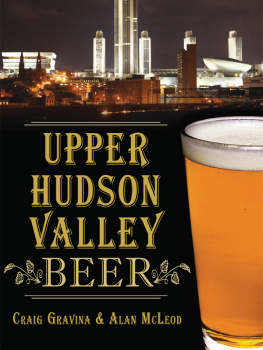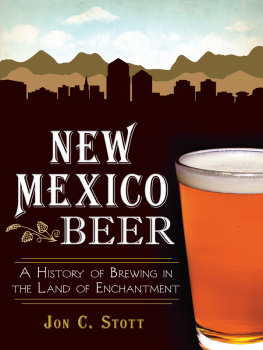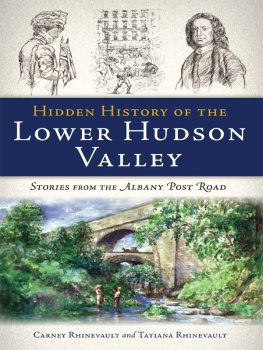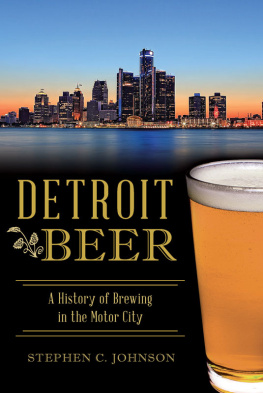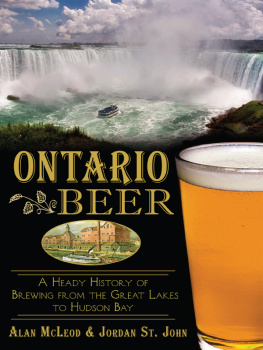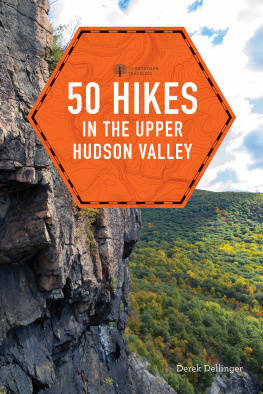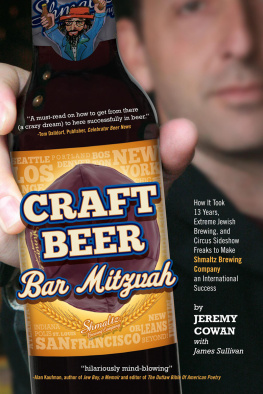
Published by American Palate
A Division of The History Press
Charleston, SC 29403
www.historypress.net
Copyright 2014 by Craig Gravina and Alan McLeod
All rights reserved
Front cover: Albany skyline. Courtesy of Albert Gnidica.
First published 2014
e-book edition 2014
ISBN 978.1.62585.045.4
Library of Congress Cataloging-in-Publication Data
Gravina, Craig, 1974- author.
Upper Hudson Valley beer / Craig Gravina and Alan McLeod.
pages cm
Includes bibliographical references and index.
print edition ISBN 978-1-62619-512-7 (paperback)
1. Brewing--Hudson River Valley Region (N.Y. and N.J.) 2. Brewing industry--Hudson River Valley Region (N.Y. and N.J.) 3. Beer--Hudson River Valley Region (N.Y. and N.J.) 4. Hudson River Valley (N.Y. and N.J.) I. McLeod, Alan, 1963- author. II. Title.
TP573.U6G73 2014
338.4766342097474--dc23
2014025442
Notice: The information in this book is true and complete to the best of our knowledge. It is offered without guarantee on the part of the authors or The History Press. The author and The History Press disclaim all liability in connection with the use of this book.
All rights reserved. No part of this book may be reproduced or transmitted in any form whatsoever without prior written permission from the publisher except in the case of brief quotations embodied in critical articles and reviews.
To our wives, neither of whom particularly like beer, but put up with us anyway.
CONTENTS
ACKNOWLEDGEMENTS
First of all, Craig would like to thank his family (Amy, Zoe and Will) and Alan would like to thank his (Ellen, Abby, David and Annie) for their patience and support.
We would like to thank everyone who contributed to the research and preparation of Upper Hudson Valley Beer. Without their help, this book would not have been possible:
The Albany Institute of History & Art, the New Netherland Project, the New York State Library, the New York State Museum, the Metropolitan Museum of Art, Vassar College, Albanythe Way It Was Facebook page, Steadfast Beer Company, Beaus All-Natural, Historic Hudson, the Lionheart Pub, C.H. Evans Brewing Company at the Albany Pump Station, Browns Brewing Company, Tamis Groft, Dr. W. Doulas McCombs, Allison Munsell, Carrie Bernardi, Aaron Nobel, Chris Kobuskie, Robyn Gibson, Viki Weiss, Paul Mercer, Craig Williams, Julie OConnor, Walter G. Ritchie Jr., Dr. Charles Ghering, Gerry Lorrentz, Chad Fust, Ethan Cox, Ron Pattinson, Martyn Cornell, Carole Osterink, Brian Welch, Aaron Connor, Jordan St. John, Deanna Fox, William S. Newman, Neil Evans, Ryan Demler, Garret Brown, Gregg Stacy, Peter Martin, John Mead, Jerry Aumand, Geoff Huth, Denis Meadows, Dieter Gehring, Colleen Ryan, Eric Hoppel, Jimmy Vielkind, Casey Seiler, Mark Crisafulli, Jeremy Hosier, Steve Beauchesne, Jordan Bamforth, Jennifer Beauchesne, Bob Kay, Chad Polenz and all the members of the Albany Ale Project.
INTRODUCTION
In the spring of 2010, Kingston, Ontariobased beer blogger Alan McLeod stumbled across an advertisement in Newfoundlands Public Ledger of October 12, 1847. The ad listed a number of products for sale by Clift, Wood & Co.coffee, tobacco, candles and Albany ale. What exactly was Albany ale? Shortly thereafter, Craig Gravina, a native of Albany and beer blogger in his own right, had joined Alan in a beery quest for the answer to that question.
The question took them on a journey through the history of New York spanning over four hundred years, from the arrival of the first Dutch explorers to the twenty-first century, and it developed into an international research endeavor dubbed the Albany Ale Project. Nearly five years later, the duo has begun piecing together the history of brewing, not just in Albany, but also the Upper Hudson Valley, laying the foundation to explore the entirety of brewing in New York State and, eventually, the country.
It became clear to the duo, quite early on, that beer does not exist in a bubble, and therefore, an account of its history in the Upper Hudson Valley cant simply be a story of beer. It has to be a larger narrative than that. It has to be an overall historya cultural, social and economic history of Albany and the Upper Hudson seen through amber-colored glasses. The success and failure of the brewing industry was directly affected by the world it occupied and still occupies. War, climate, law, ethnicity and a myriad ofwhat might be considered unrelatedfactors in fact give context to the story of Upper Hudson Valley beer.
Although this book delves rather deep into the brewing heritage of the Upper Hudson Valley, it would be impossible to include every brew house and brewery in the nearly seven hundred square miles this book covers. Every hamlet and village between Canajoharie and Hoosick and Saratoga Springs to Kingston most likely had some sort of brewing establishment. But there are simply not enough pages to include them all.
THE DUTCH AND NEW NETHERLAND IN THE 1600S
The European newcomers who came from across the Atlantic in the early 1600s had a taste for beer. It should not come as any surprise as all European communities, and especially oceangoing crews, depended on a regular supply of grain-based drinks as a safe and nutritious supply of fluid. Water was simply too unhealthy to rely on. As soon as land was reached, personal or communal ale brewing would have been one of the first activities to be undertaken. With the stabilization of the settlement, personal brewing turned to commercial as small taverns were established, which were in turn followed by larger stand-alone breweries.
Brewing became a cornerstone of society. Some of the families who founded the first commercial breweries in the region passed the skill and wealth created on for generations, turning local indigenous hops and surplus wheat sown for export into small empires and, eventually, political power. Striking an alliance with the Mohawk Nation, the Dutch in the Upper Hudson built themselves security for over four decades until conflict between global empires saw the community pass from Dutch to English control. Rather than be overrun by settlers with other tongues and other customs as might have been expected, the Dutch community was left largely to itself, protected by treaties and accords as well as its relative isolation. As the seventeenth century came to a close, despite dangers from New France to the north, the wheat-brewing culture of the Dutch was expanding in geography and population.
DUTCH DRINKING HABITS IN THE EARLY 1600S
The Dutch who settled the Upper Hudson were drinkers and had been for centuries. The role of beer was central to the culture with brewing processes in the early 1600s not being that different from those of the mid-1400s. The historian Richard Unger describes the years 1450 to 1650 as the golden age of Dutch brewing. In 1600, the citizens of Amsterdam drank an average of over 250 liters of beer annually. Skilled workers and laborers drank more. Sailors in the late 1500s were allotted 4 liters of beer per day. The Dutch brewed with wheat, barley, oats and rye, with wheat being the most prized and therefore most expensive. The taxation of beer was a major source of revenue for the state. Dutch control of northern European shipping trade routes was necessary to protect its need to feed its demand for imported grain brought in from as near as France and as far as the Baltic. Much of that grain was destined for the brewing trade.
THE VOYAGE OF THE HALF MOON
In 1609, when the Half Moon, commanded by Henry Hudson, entered the mouth of the river that would one day bear his name, it found itself in a busy, populated valley. The river valley and the shores and islands around the mouth were the home to many communities and a number of peoples who spoke a number of related Algonquian languages. They were known as the Lenapes to the south and the Mahicans to the north. The Mahicans named the great river on which they traveled
Next page
